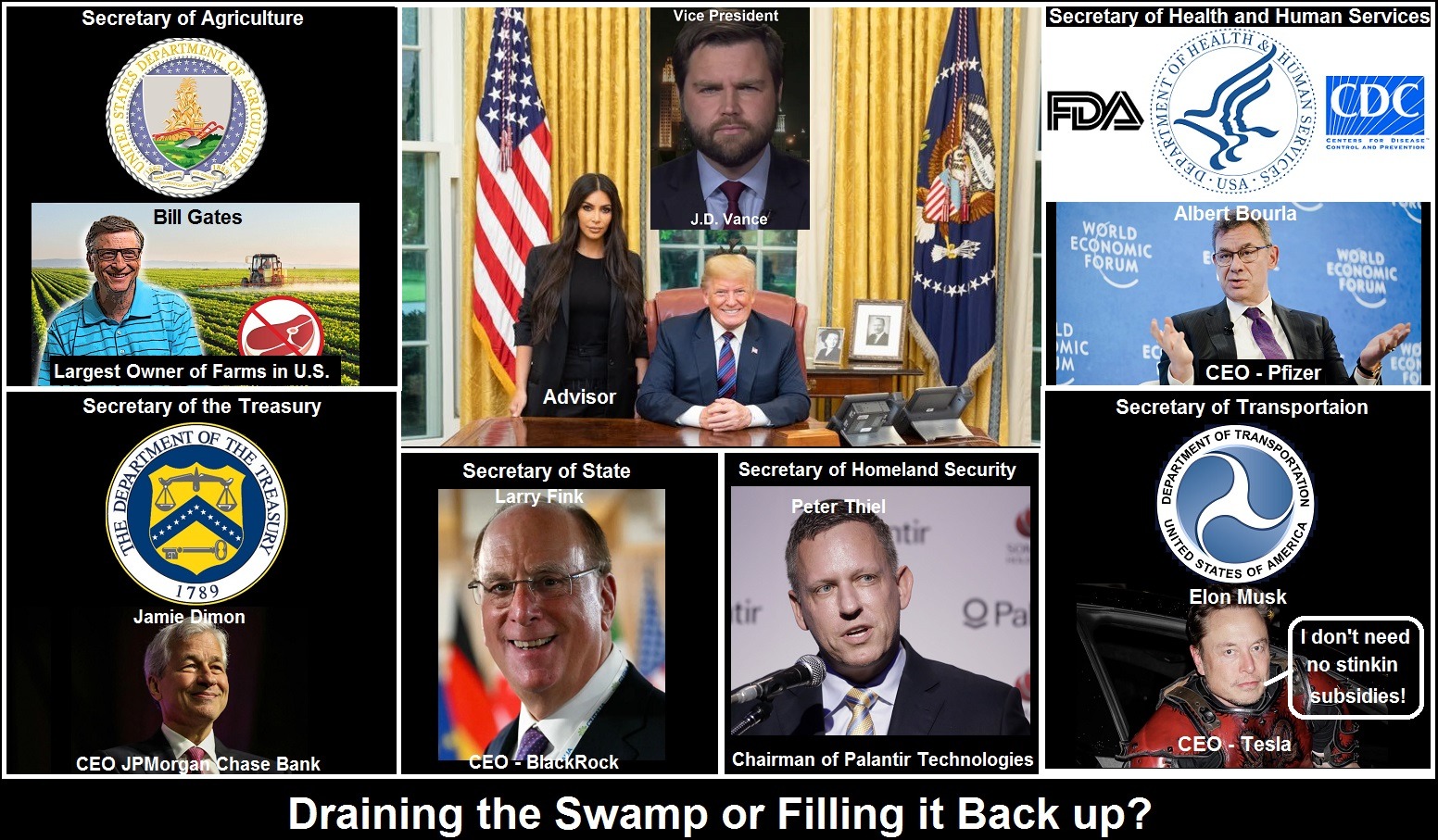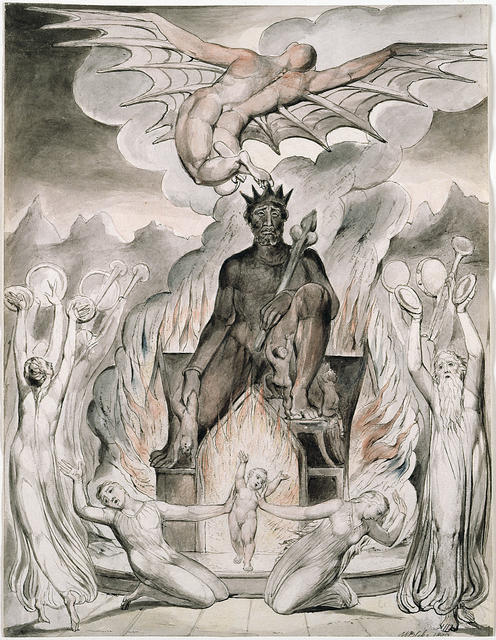
Left: J.D. Vance – Center: Curtis Yarvin – Right: Peter Thiel. Image by Clark Miller. Source.
Comments by Brian Shilhavy
Editor, Health Impact News
I have frequently reported in my articles that politicians are not the main people who run the U.S., but that Wall St. billionaires and Silicon Valley billionaires do.
Unlike publicly visible politicians who at least have the illusion of accountability, the billionaires who fund them usually do not.
So it is a rare treat when I find an article like the one that The Information published in their Weekend publication that does just that, and exposes where a lot of the new “Far Right” ideology originates from which many Silicon Valley billionaires subscribe to.
The article was written by Julia Black, and titled:
The Far-Right Guru Who Has Befriended Silicon Valley’s Extreme Factions
Judging by the comments submitted to the article so far, it appears that this article is sending shock waves among those in Tech.
It is behind a paywall and a subscription is needed (which is well worth it as I find The Information the best source of “alternative” views on Big Tech with very solid journalism), but I will provide some excerpts and highlights here.
Featured in the article is one of Big Tech’s own, J.D. Vance, who recently became Trump’s Vice President choice, and how he has been influenced by Peter Thiel, who for years has followed the teachings of Curtis Yarvin, who believes “democracy” in the U.S. should be replaced by a “monarchy” instead.
Curtis Yarvin has found a place among the most right wing in tech.
In recent weeks, Democrats have relentlessly blistered Donald Trump and his running mate, J.D. Vance, using a straightforward message: They’re too weird to hold high office.
If Trump and Vance are weird, imagine what the American public might make of Curtis Yarvin, 51, whose far-right thinking has influenced both Vance and, increasingly, members of the Silicon Valley right, including billionaires Peter Thiel and Marc Andreessen. Both Thiel’s Founders Fund and Andreessen Horowitz have invested in Yarvin’s work.
As an intellectual godfather to these conservatives, Yarvin has laid out a philosophy in which he suggests replacing American democracy with a monarchy.
At a recent Palo Alto, Calif., reading of his poetry, he asked his audience to wear “cocktail attire for the new regime.” He has referred to himself and his friends as “dark elves” on a heroic journey to rescue the know-nothing “hobbits” who make up the American populace.
And last summer, Yarvin decided that Vibecamp, an annual Burning Man–style meetup of contrarian techies in rural Maryland, wasn’t contrarian enough. So he threw his own party in Washington that attendees called Vibekampf.
For now, Yarvin has found a place among Silicon Valley’s most ardent conservatives. His presence there matters. He has won the friendship and interest of people who possess great wealth and those in their own deep networks of influence.
By winning their attention, Yarvin has increased the chance that his ideas can spread further and seep deeper into the mainstream. (Source – emphasis mine.)
These new Big Tech “conservatives” use familiar terms with the Right, but with completely different meanings. So while “limited government” is a traditional, conservative and libertarian value, they take it even further by advocating NO government.
What does (Yarvin’s teaching) entail exactly?
He’d like to see American democracy as we know it collapse, with the country electing a president who could then rule as a dictator.
Under his plans, Yarvin has further proposed to seize private assets, replace the free press with state-run media and purge any officials deemed insufficiently loyal to the new regime.
Though he has deliberately maintained a low profile, chances are you’ve caught wind of his ideas: In the 2000s, for instance, Yarvin co-opted the term “red pill” from the “Matrix” movies to describe the political awakening of the new right wing.
While Yarvin has worked to push his ideas on America’s GOP political elite, he has also made inroads among tech’s conservative elite.
His primary conduit has been Thiel, who has introduced Yarvin to others in his circle. In addition, Yarvin has been welcomed into the homes of Marc Andreessen and PayPal co-founder Luke Nosek.
And you can detect distinct traces of Yarvinian thinking in written work like Andreessen’s 2023 “Techno-Optimist Manifesto” and “The Network State,” a book by Balaji Srinivasan, Coinbase’s former chief technology officer, which envisions a system of new sovereign entities built on decentralized networks.
J.D. Vance is also one of his disciples, and they undoubtedly paid Trump a handsome sum to ensure Vance got picked as the VP.
What might further propel Yarvin’s philosophy is a second Trump presidency, with Trump’s strong reelection campaign already emboldening the GOP intelligentsia and the conservative technorati to speak up about their beliefs.
Moreover, Yarvin already has a relationship with Trump’s running mate, J.D. Vance. Thiel introduced them.
Yarvin would only speak to me via email, and when I asked him about Vance, he praised the vice presidential candidate and suggested Vance has more to learn from him: “Seems nice. Kind of a normie still. Not sure if he totally gets it.” (Thiel, Andreessen, Nosek, Srinivasan and Vance did not respond to requests for comment.)
[T]he Yarvin associate perhaps poised to wield the most influence is J.D. Vance.
In 2021, Vance told podcaster Jack Murphy he’d been reading Yarvin’s arguments that “we should basically eliminate the administrative state,” adding that he found himself “sympathetic to that project.”
Vance doubled down on the theory the next year, saying that he would advise Trump to “fire every single mid-level bureaucrat…and when the courts stop you, stand before the country, and say, the chief justice has made his ruling. Now let him enforce it,” according to Vanity Fair.
That, of course, sounds a lot like something Yarvin would say. In 2012, Yarvin coined the acronym RAGE: Retire All Government Employees.
Another term these new Big Tech “conservatives” like to use which has a wide appeal to the Right, is dismantling the “Deep State.”
One of Yarvin’s core objectives is dismantling what conservatives like to call the deep state. There’s some irony in that. He was born into a deep state family: His father was a foreign service officer for the U.S. State Department, who brought Yarvin along with him to postings in Cyprus and Portugal.
He started a blog called “Unqualified Reservations” in 2007, using it to develop an ultra-libertarian ideology he named formalism.
In his ideal system, America would eliminate the elites powering the media, academia and the administrative state, allowing the nation to run like a corporation managed by an omnipotent sovereign.
This idea of running America like a corporation began to influence Peter Thiel around that same time (2007-2009). They began to see CEOs of Big Tech as “all-powerful rulers,” even suggesting that Apple co-founder Steve Jobs should have been given “absolute power over the state of California.”
Though the precise origins of his friendship with Thiel are unknown, early hints of Yarvin’s influence began to appear in Thiel’s public statements around this time.
“I no longer believe that freedom and democracy are compatible,” Thiel wrote in a 2009 article. A month later, Yarvin linked to the piece in a blog post titled “Democraphobia goes (slightly) viral.” He wrote, “You read it here first.”
In 2012, Thiel was a guest lecturer for an undergraduate course at Stanford University, where he echoed some of Yarvin’s prior work comparing CEOs to all-powerful rulers.
Thiel’s Stanford class also introduced a novel framework for analyzing founders, which included an analysis of “Steve Jobs as god.”
In 2008, Yarvin had suggested giving Steve Jobs absolute power over the state of California.
These ideas may seem outrageous and even “fringe”, but they have made inroads into American politics for years now, including Steve Bannon, who served in Trump’s first term.
Another early fan of Yarvin’s work was former top Trump strategist Steve Bannon, whose interest in neoreactionary thought led to a flurry of media interest in Yarvin’s White House influence in 2017.
Anton, the Trump staffer who’s now at the Claremont Institute, also read Yarvin’s work. He was drawn to Yarvin’s critiques of widely accepted American political beliefs that most people never questioned, a “deep skepticism of the current moment and the current reigning orthodoxies,” he said.
As the Republican establishment has morphed in recent years, the shift has created more room for ideas like Yarvin’s. For instance, look at Project 2025, the policy proposals that the Heritage Foundation hopes will form the intellectual bedrock of a Trump presidency. (Amid Democrats’ criticism of Project 2025, Trump has tried to distance himself from it.)
Project 2025 includes a proposal to dismantle the entire federal bureaucracy and place its functions under the direct control of the president, calling it “unitary executive theory.”
The similarities between Project 2025 and Yarvin’s philosophy haven’t gone unnoticed.
Yarvin has continued to solidify his theories. In March, he wrote a Substack post titled “A conversation about monarchy” in which he outlines a step-by-step, 8,000-word plan to discard American democracy and replace it with “a new regime of absolute executive supremacy.”
In that plan, America would elect a president who’d act as a supreme ruler. This new America would commence with a weeklong, pandemic-style lockdown, giving the country a chance to acclimate to the new reality.
Next, America would eliminate much of the federal government, helping boost the supreme ruler’s executive power—imagining a scenario where the commander in chief operates as a CEO with total control. The dictator-president would take unilateral control of the Federal Reserve, restructuring the financial system by collapsing all assets to cash and instituting “some expropriation of the ultra-wealthy.”
He continued, “This new infrastructure will run at or near startup efficiency—it must be run like Apple, not like the Department of Transportation.”
Law enforcement officers would wear red armbands. Schools would be dismantled, as would the mainstream press, which Yarvin refers to as “termites.” Hopefully, Yarvin writes, the changes would happen swiftly and encounter little resistance, so that “no one needs to get shot.”
I asked Yarvin if I was misinterpreting his plans. “I am completely serious,” he said. “Especially about the red armbands.”
Read the full article at The Information.
If Trump and Vance gain control of the Federal Government, many of these “fringe, far right” ideas will be attempted.
But that also presupposes that the technology will be there to implement all this, and that is anything but certain, as a lot of this technology, especially the AI bubble, is on the brink of collapsing the entire world economic system.
Related Reading:
What Might Donald Trump’s Cabinet Look Like in a Second Term? Would He Drain the Swamp – Or Fill it Back Up?
Major July 2024 Events: Republican National Convention vs. Sun Valley Conference for Billionaires – Which One Will Shape “Elections”?
Why did Big Tech Billionaires Fund the Distribution of Sound of Freedom? The “New Right” Technocrats are Redefining Conservative Politics and Religious Values
This article was written by Human Superior Intelligence (HSI)
See Also:
Understand the Times We are Currently Living Through
The True Gospel of Jesus Christ Threatens the Business of the Freemasons and Technocrats
Who are God’s “Chosen People”?
KABBALAH: The Anti-Christ Religion of Satan that Controls the World Today
Christian Teaching on Sex and Marriage vs. The Actual Biblical Teaching
Exposing the Christian Zionism Cult
The Bewitching of America with the Evil Eye and the Mark of the Beast
Jesus Christ’s Opposition to the Jewish State: Lessons for Today
Identifying the Luciferian Globalists Implementing the New World Order – Who are the “Jews”?
The Brain Myth: Your Intellect and Thoughts Originate in Your Heart, Not Your Brain
What is the Condition of Your Heart? The Superiority of the Human Heart over the Human Brain
The Seal and Mark of God is Far More Important than the “Mark of the Beast” – Are You Prepared for What’s Coming?
The Satanic Roots to Modern Medicine – The Image of the Beast?
Medicine: Idolatry in the Twenty First Century – 10-Year-Old Article More Relevant Today than the Day it was Written
Having problems receiving our emails? See:
How to Beat Internet Censorship and Create Your Own Newsfeed
We Are Now on Telegram. Video channels at Bitchute, and Odysee.
If our website is seized and shut down, find us on Telegram, as well as Bitchute and Odysee for further instructions about where to find us.
If you use the TOR Onion browser, here are the links and corresponding URLs to use in the TOR browser to find us on the Dark Web: Health Impact News, Vaccine Impact, Medical Kidnap, Created4Health, CoconutOil.com.

























2 Comments